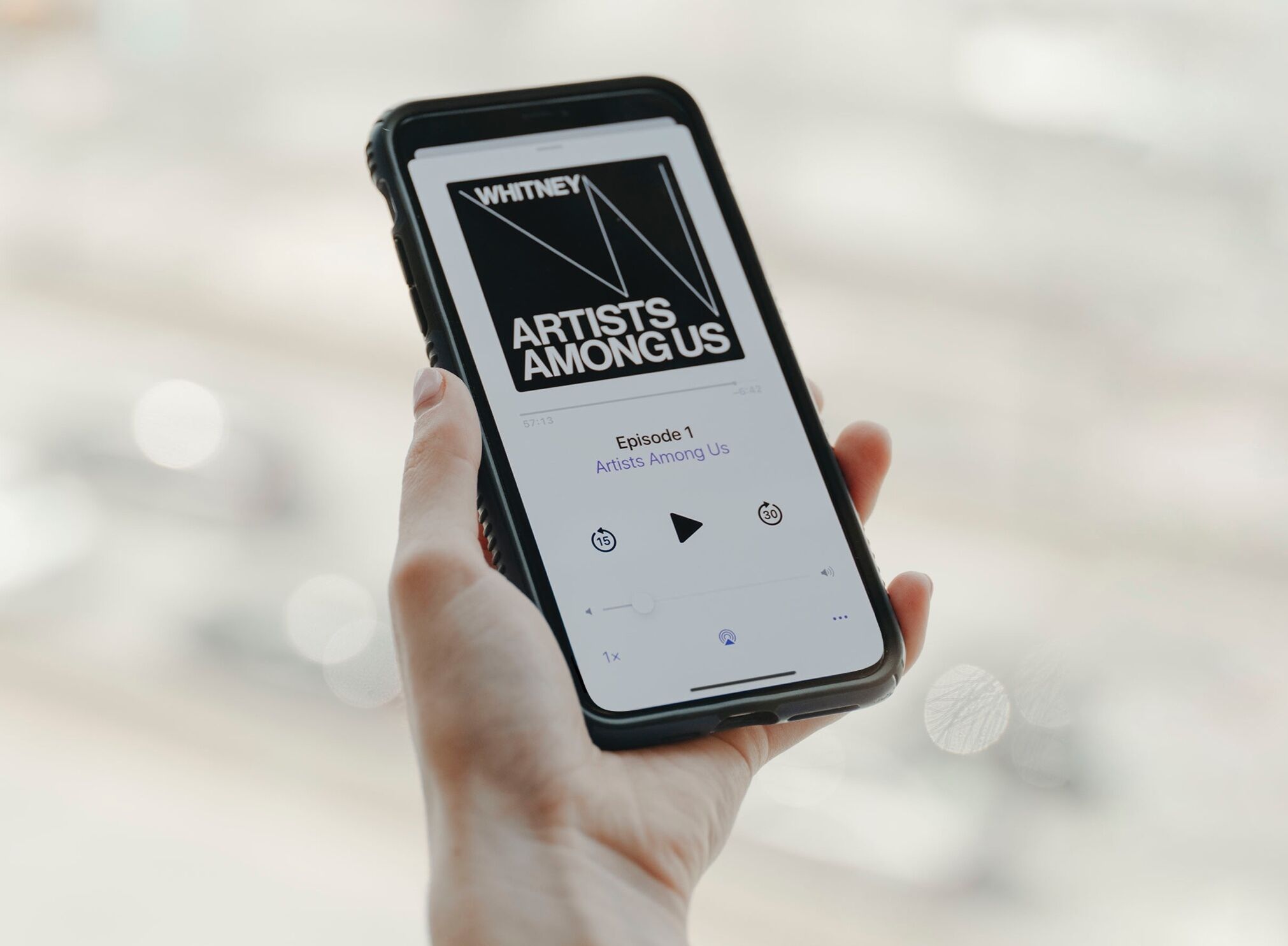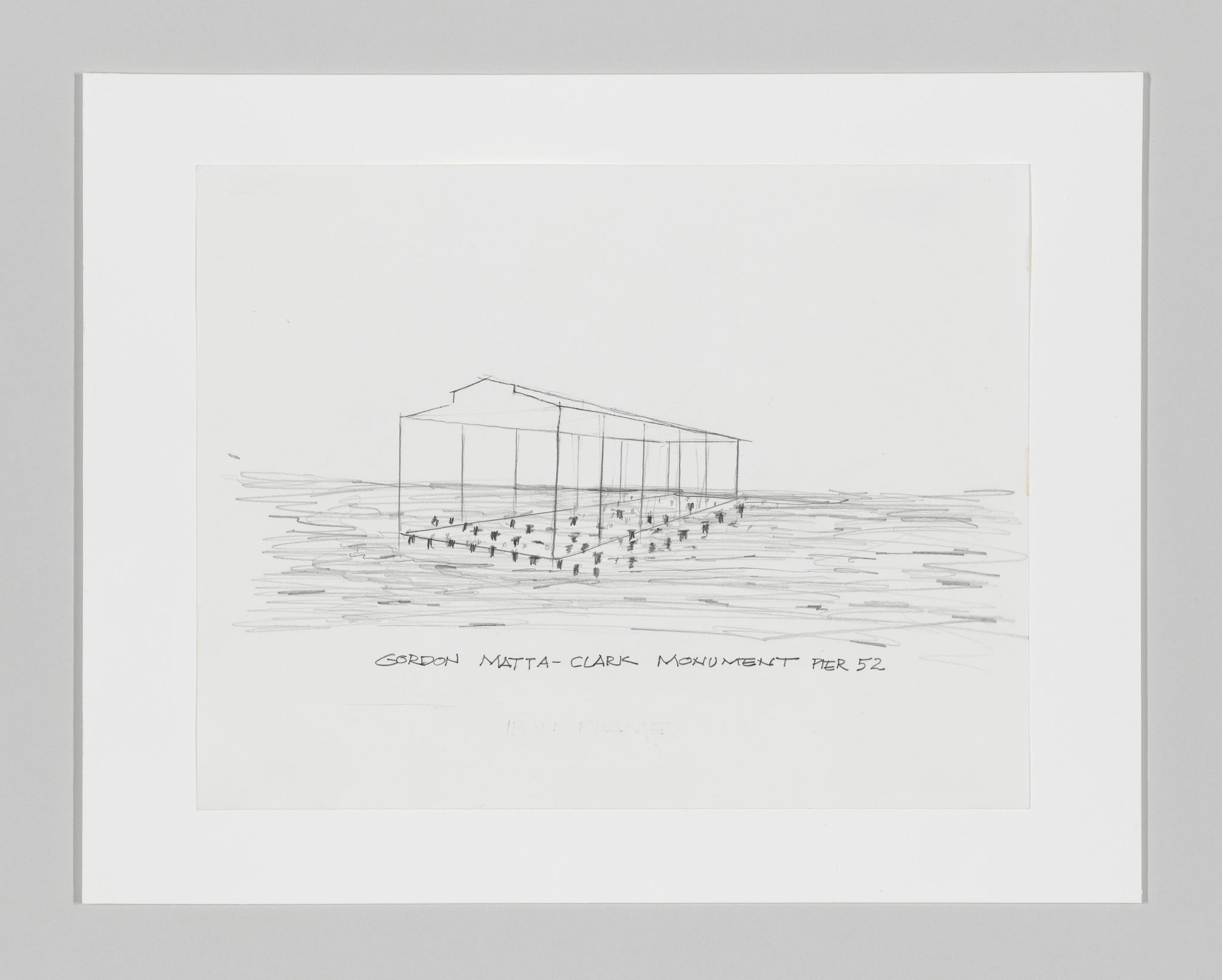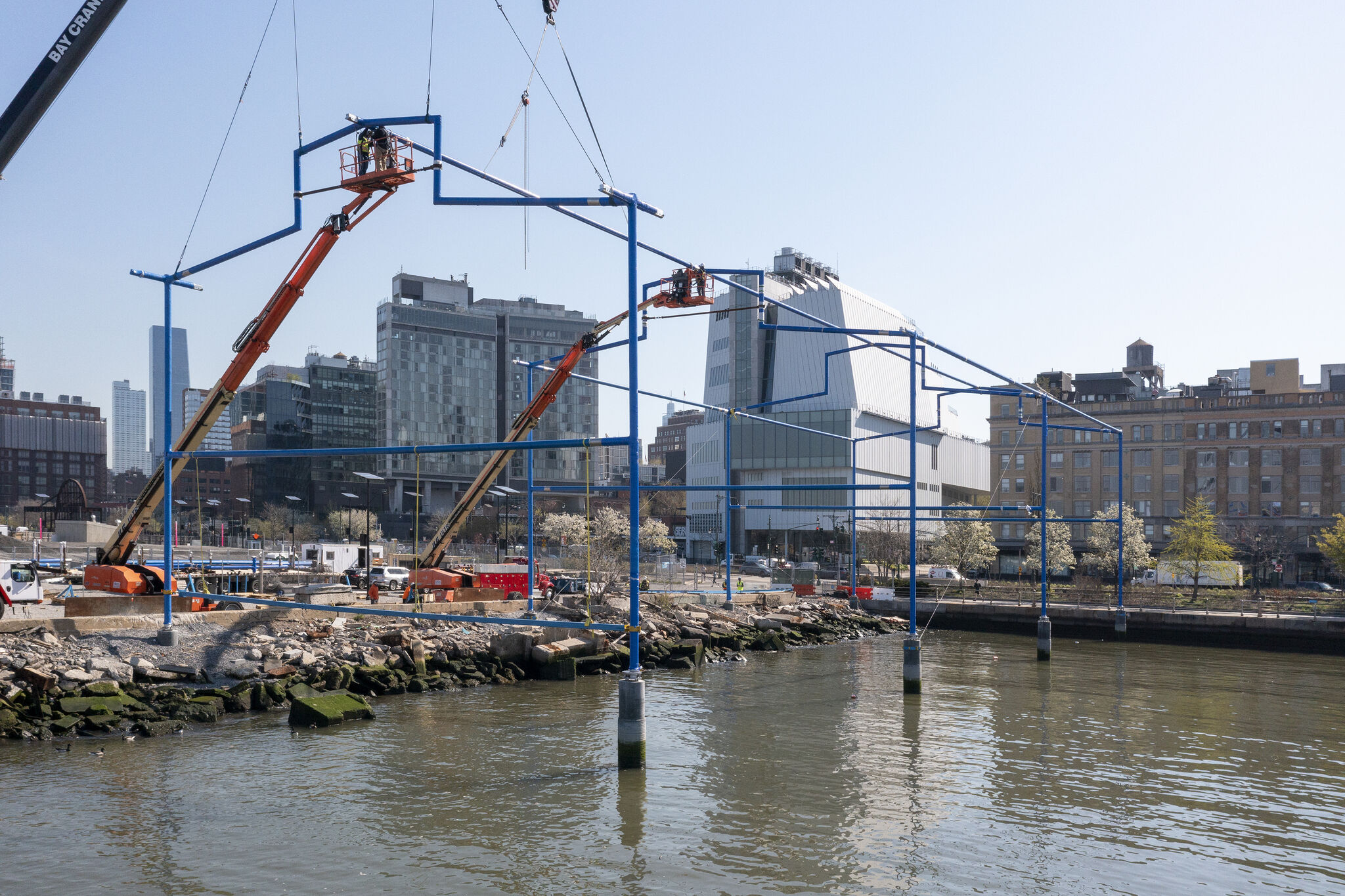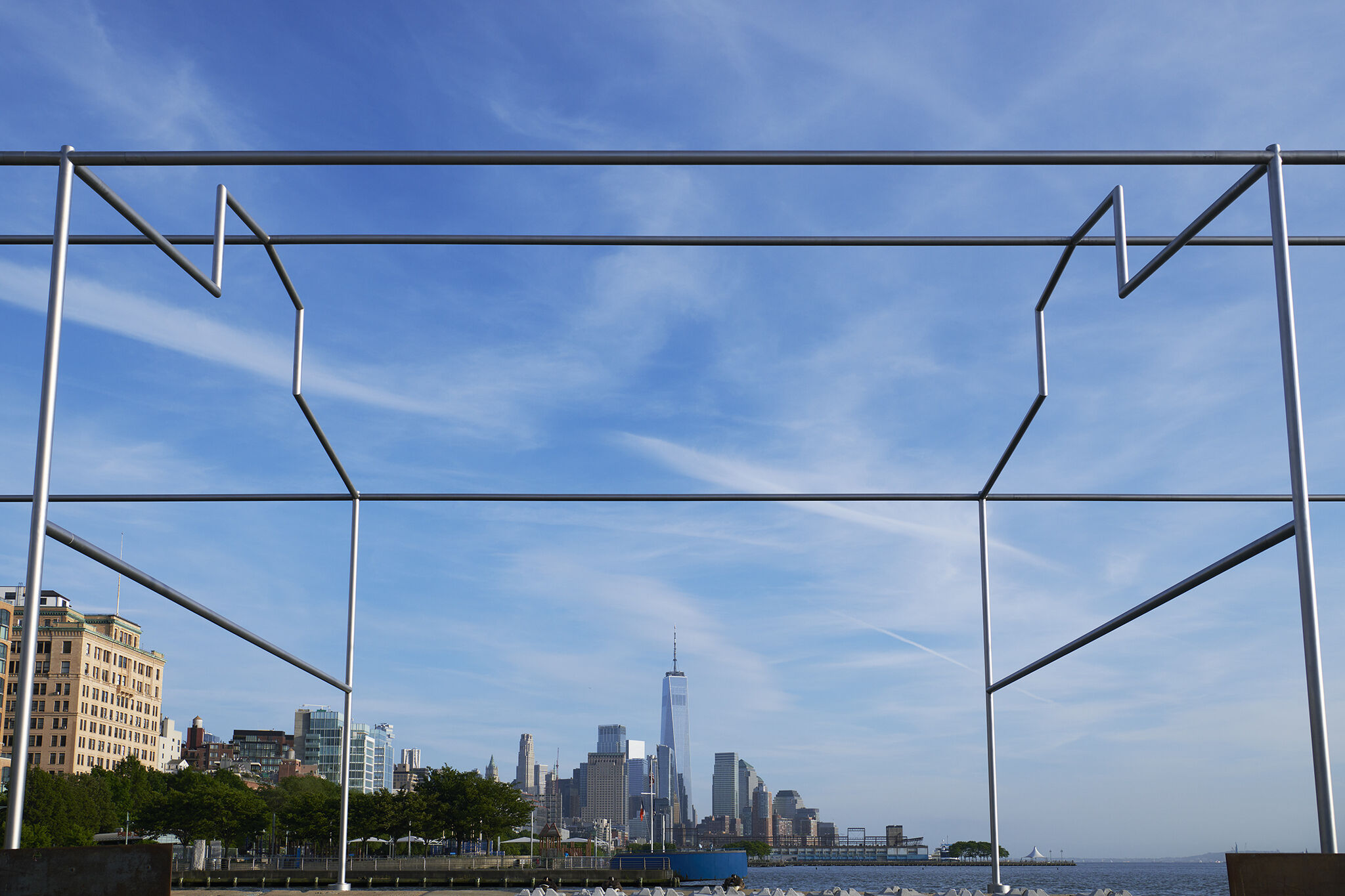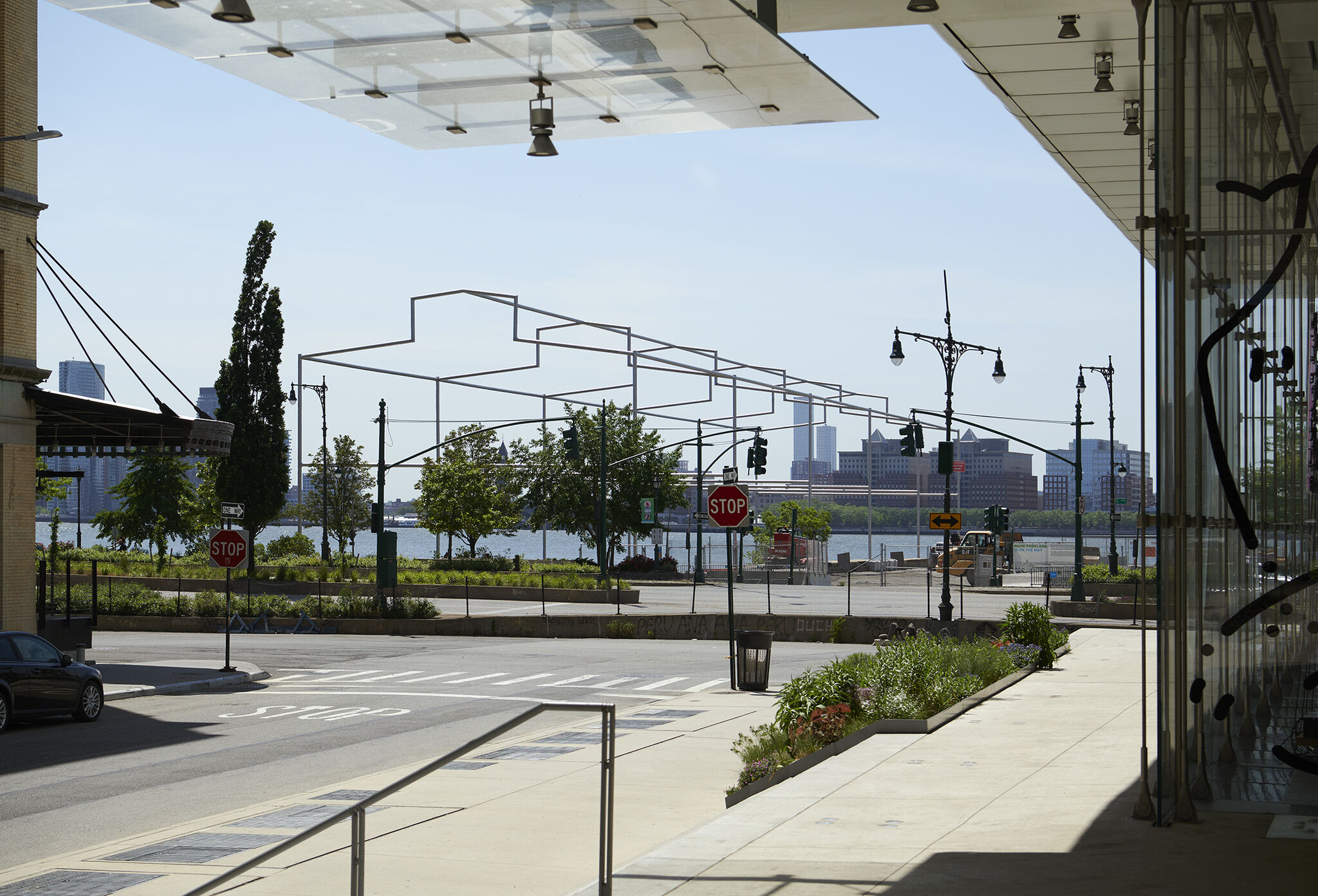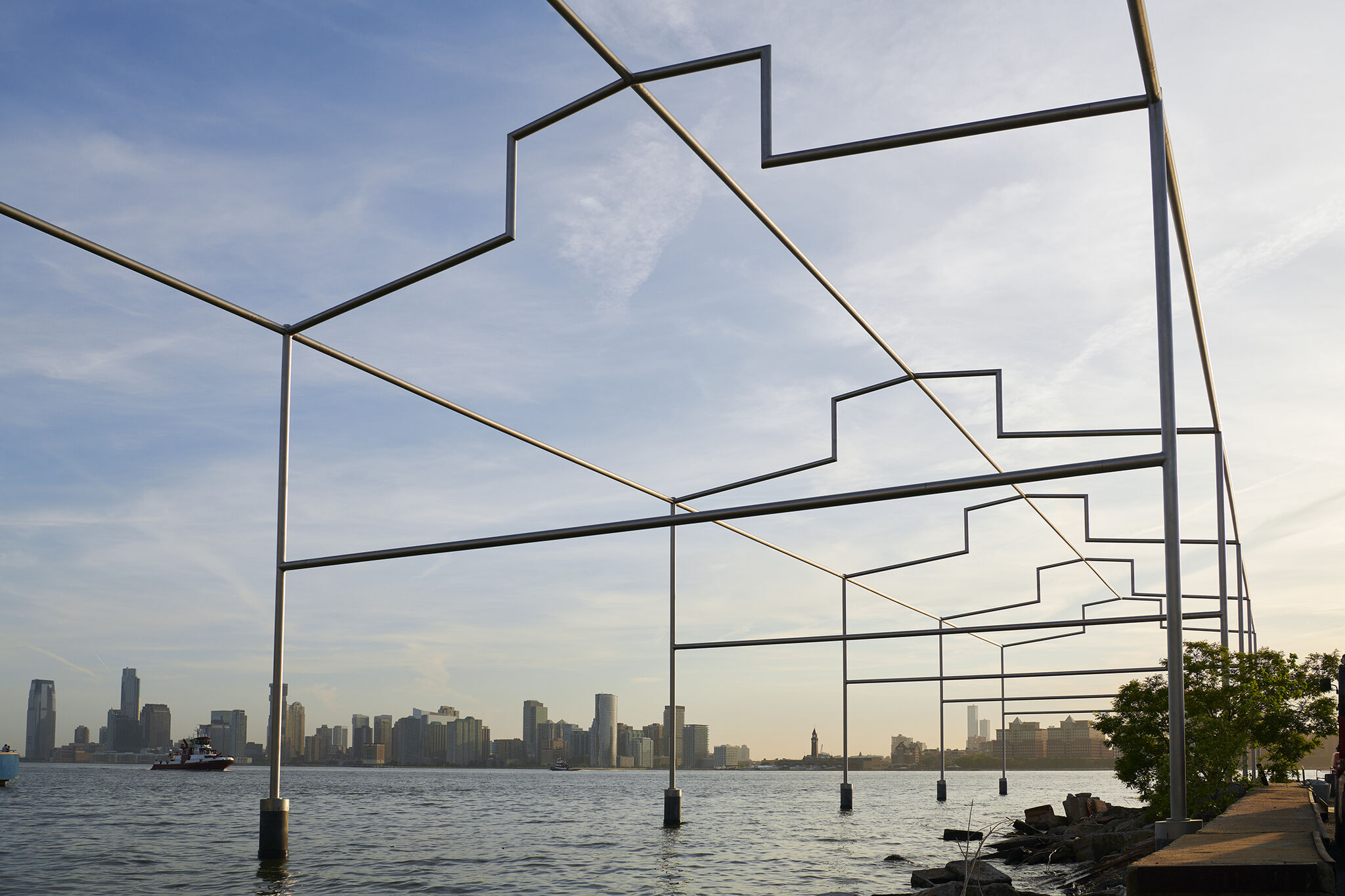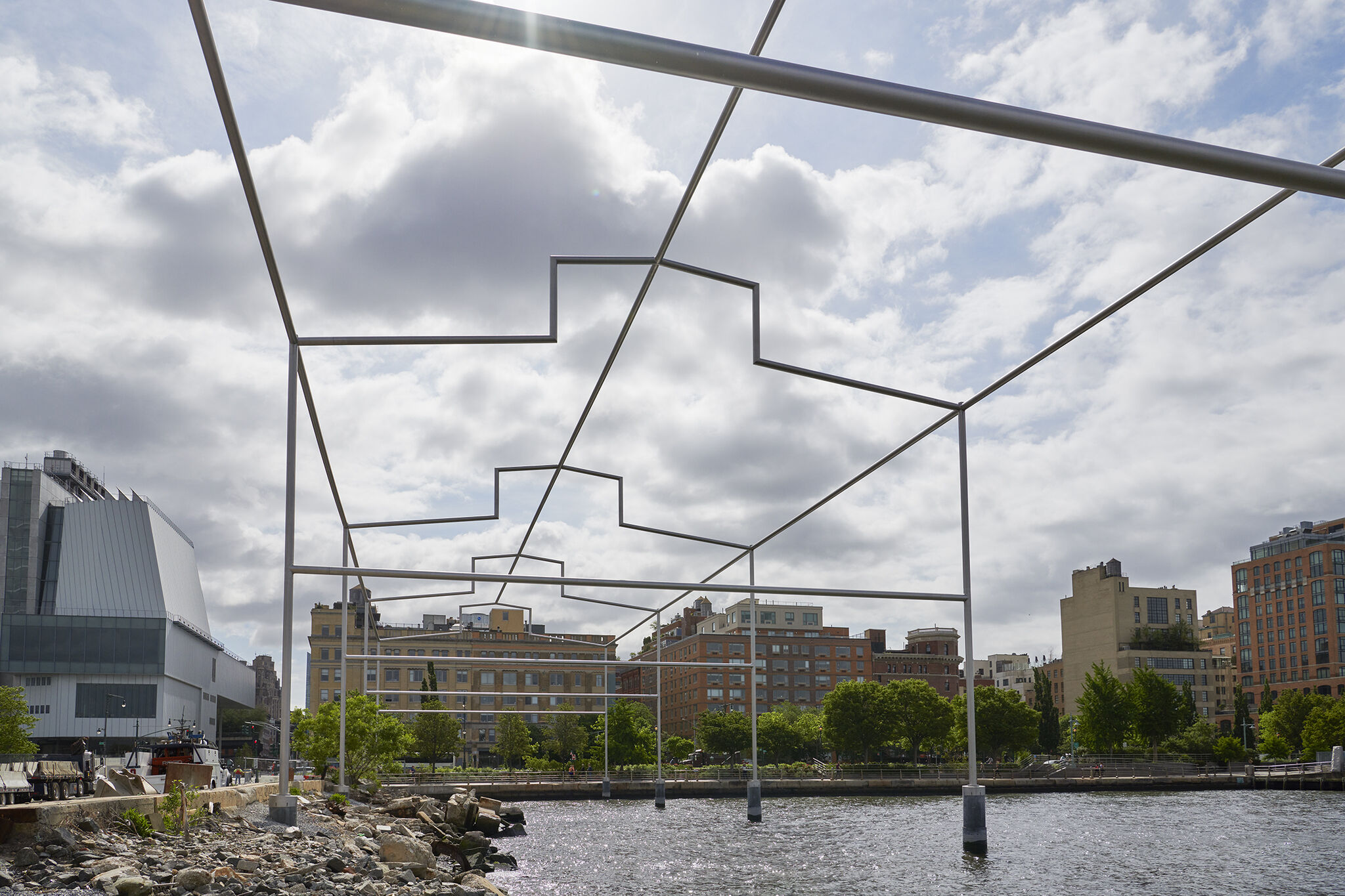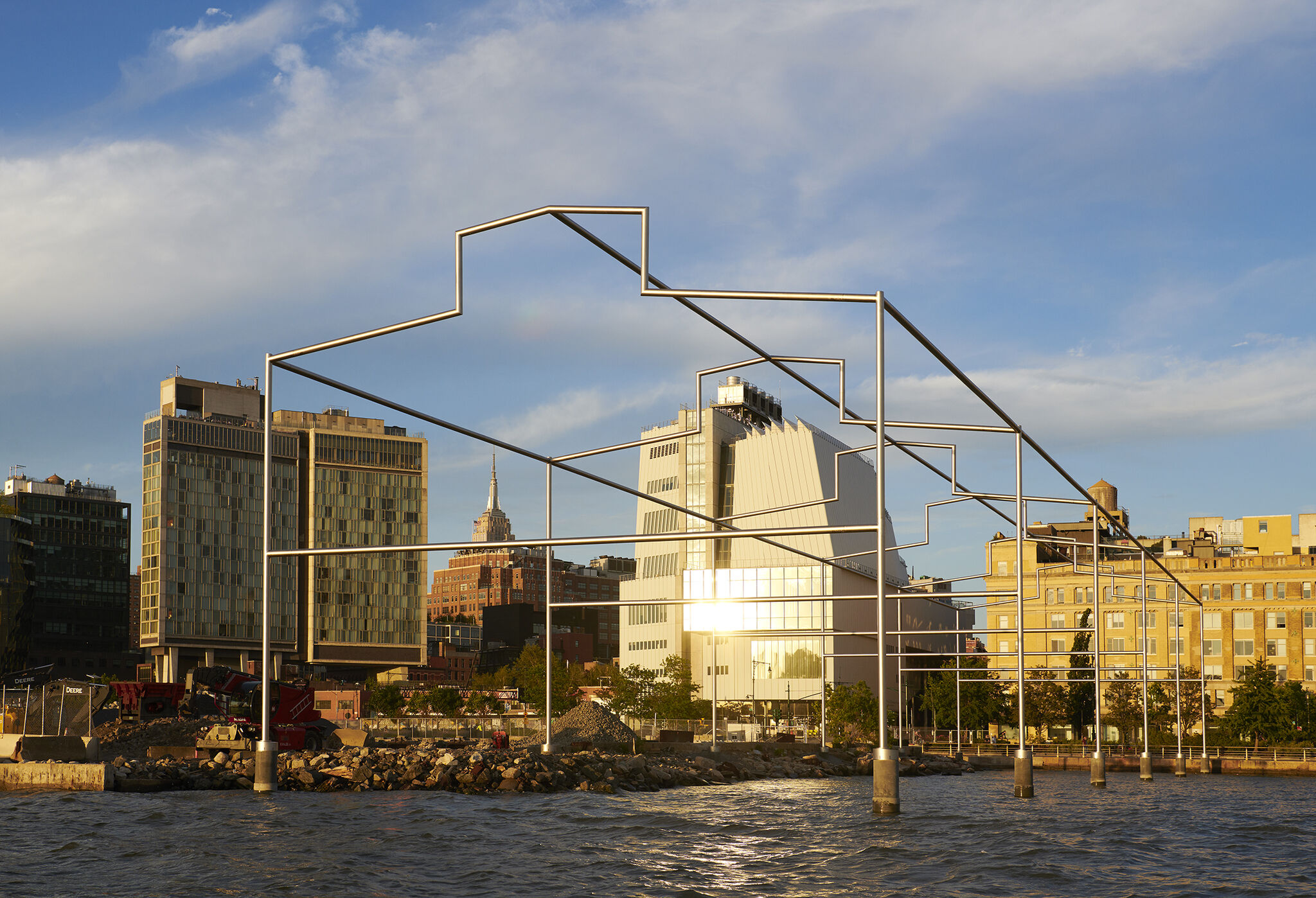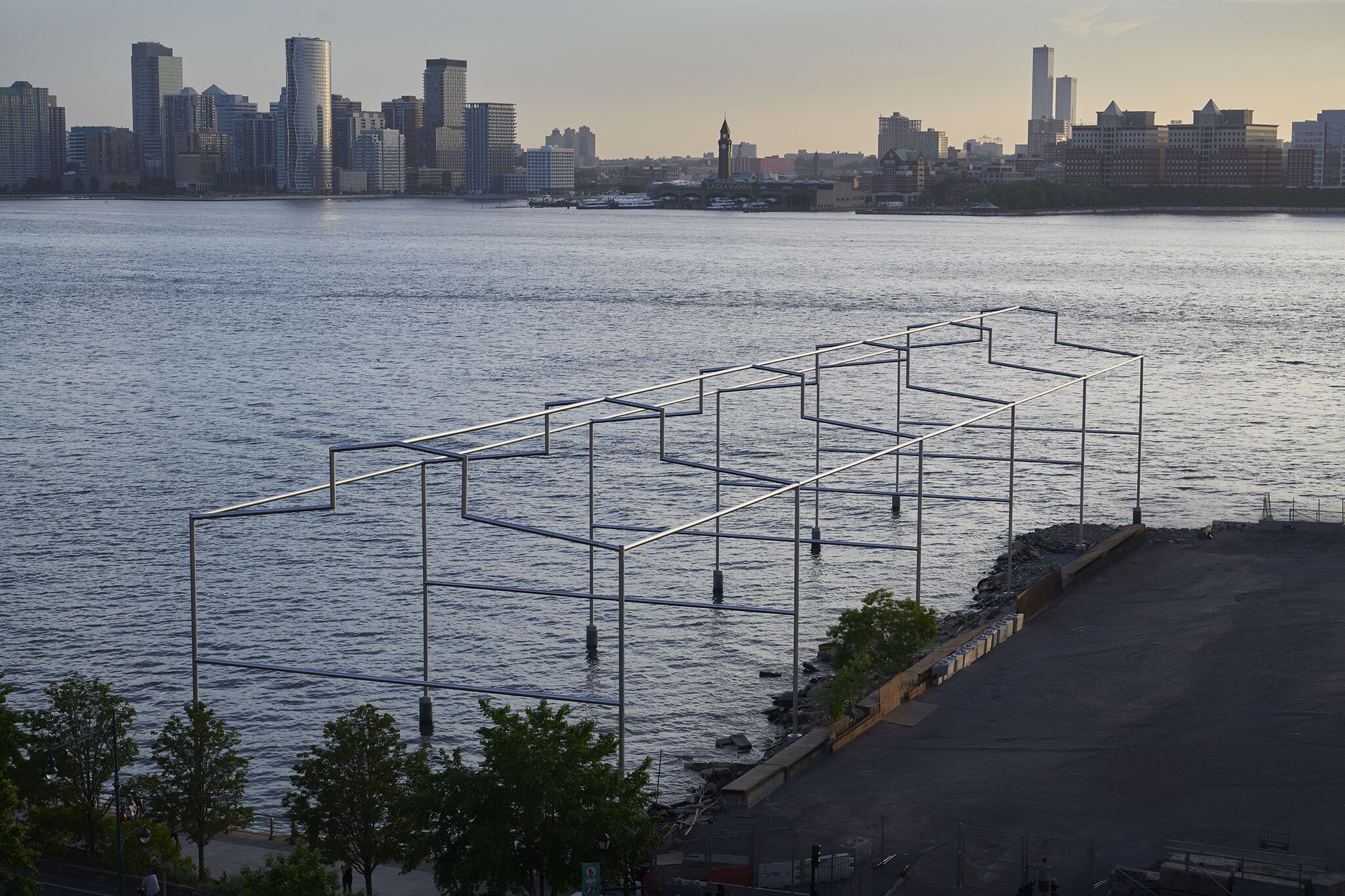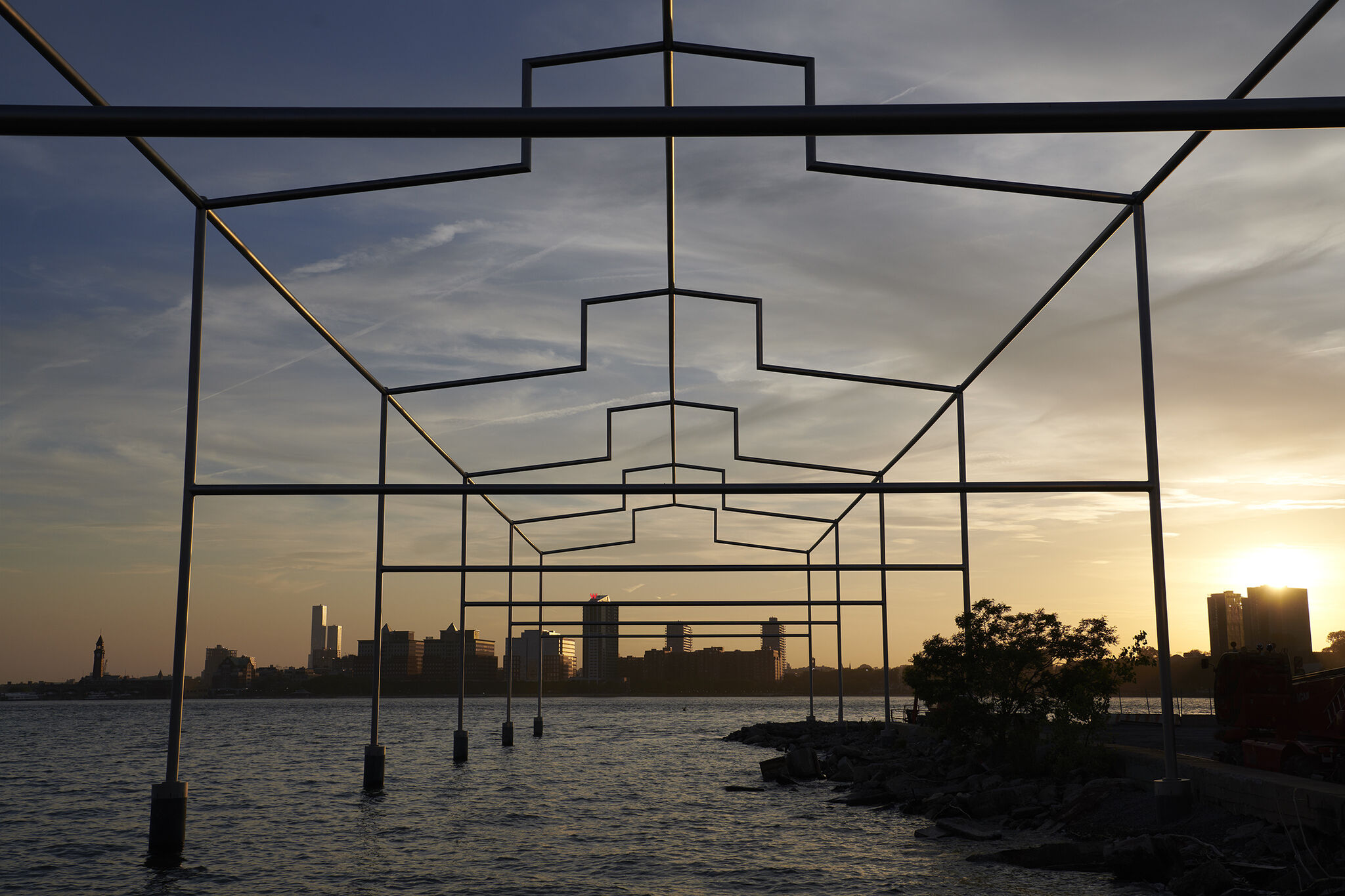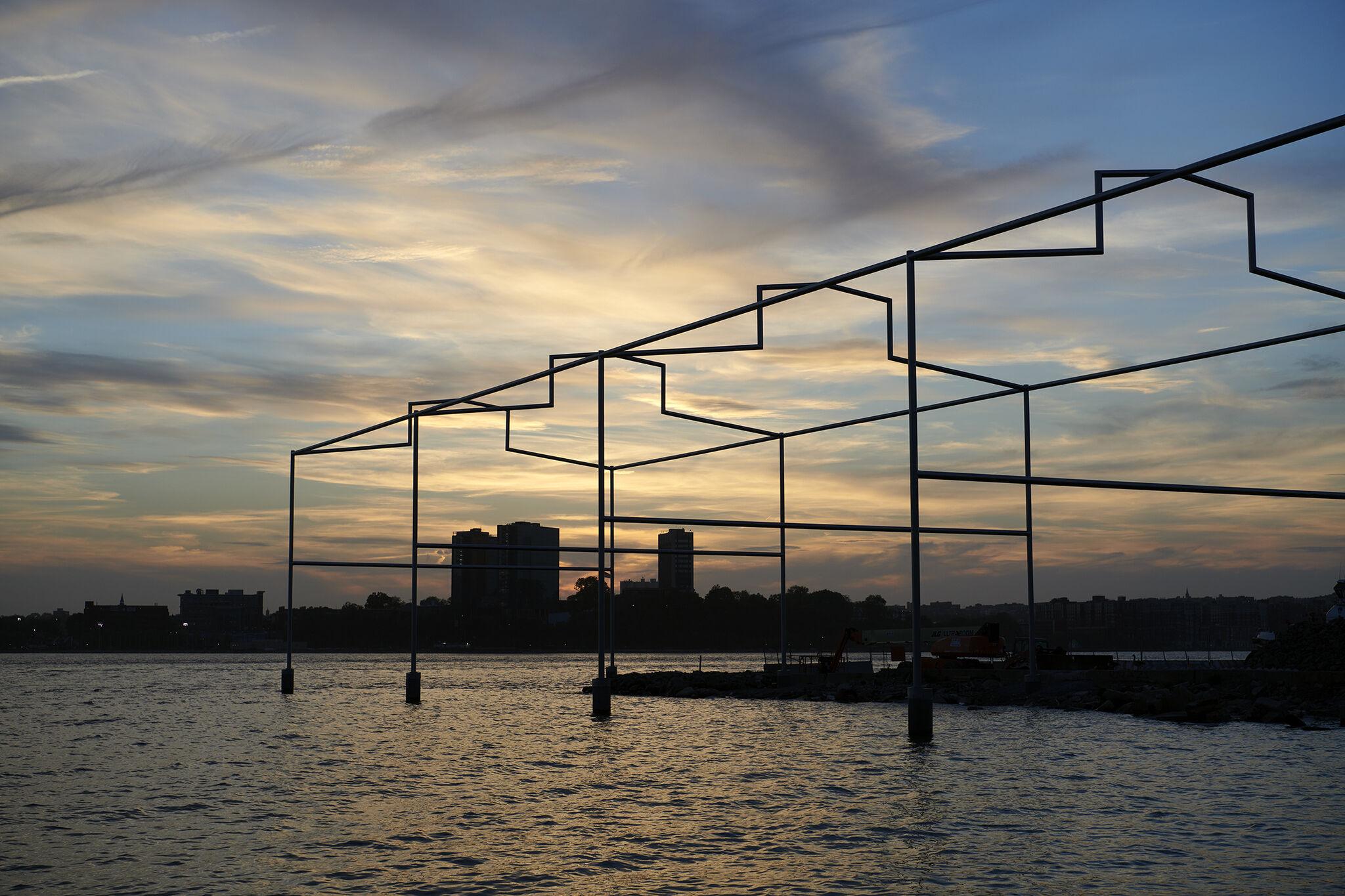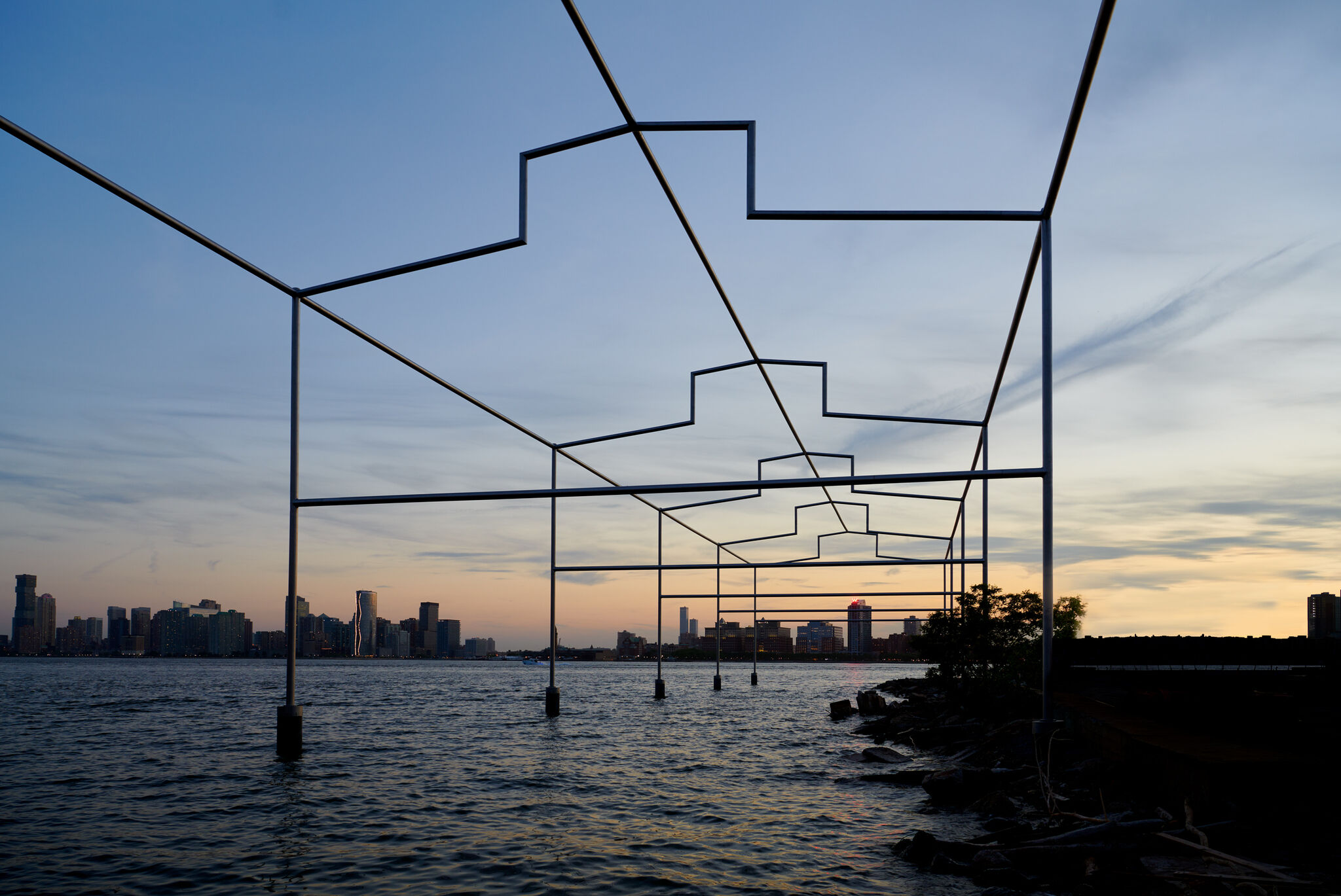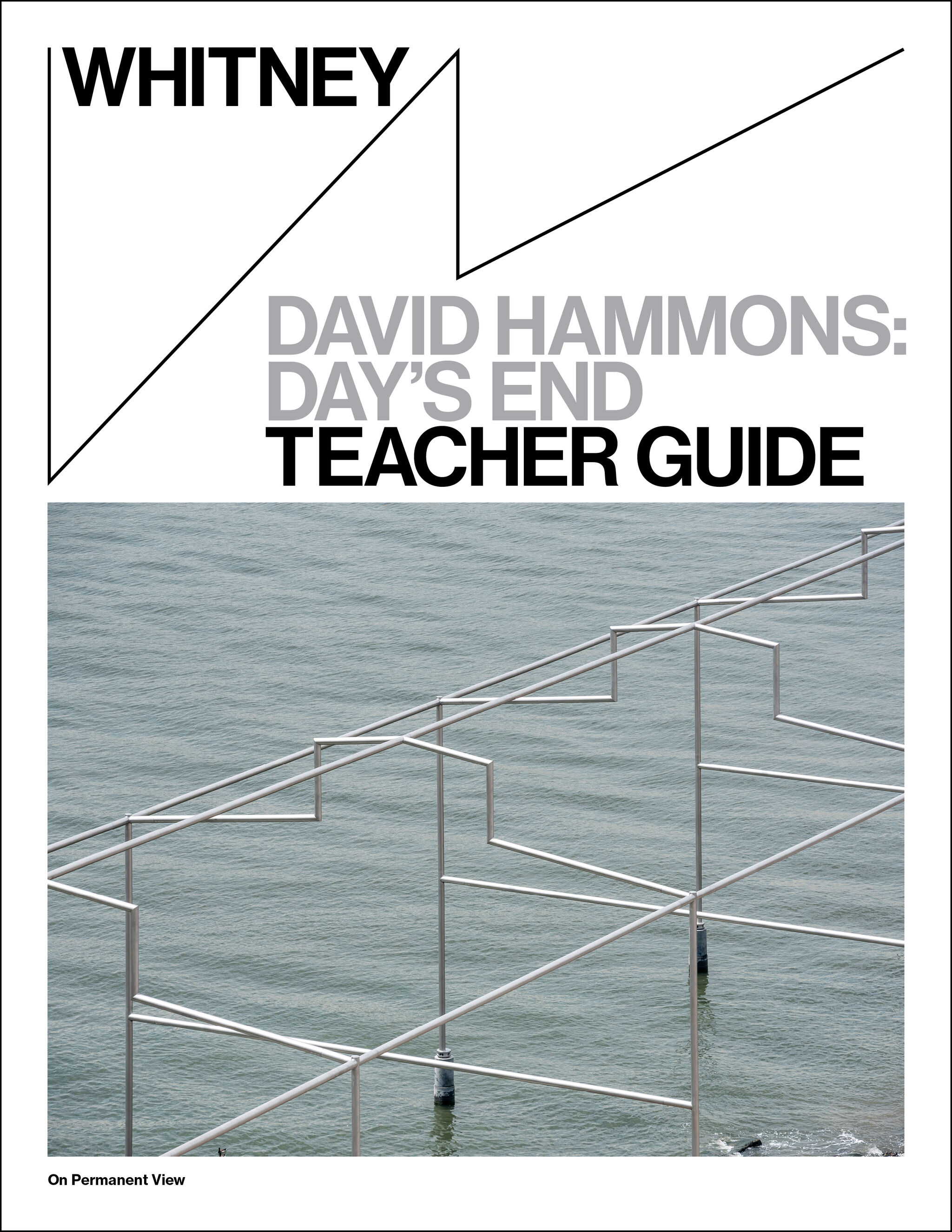David Hammons: Day’s End
On view
Hudson River Park, across from the Museum
The Whitney, in collaboration with Hudson River Park, has developed a permanent public art project by David Hammons (b. 1943). Entitled Day’s End (2014–21), this monumental installation is located in Hudson River Park along the southern edge of Gansevoort Peninsula, directly across from the Museum.
Proposed to the Whitney by Hammons, Day’s End takes inspiration from an artwork of the same name by Gordon Matta-Clark (1943–78). In 1975, Matta-Clark cut five openings into the Pier 52 shed that formerly occupied the site. Hammons’s Day’s End is an open structure that precisely follows the outlines, dimensions, and location of the original shed—and, like Matta-Clark’s intervention, it will offer an extraordinary place to experience the waterfront.
In tandem with the project's realization, the Whitney presented Around Day’s End: Downtown New York, 1970–1986, an exhibition which featured works from the collection that relate to Matta-Clark’s seminal project. The Whitney has also created interpretive materials including the Museum's first podcast series, Artists Among Us, as well as videos and neighborhood walking tours. This supporting media takes both Day’s Ends, as envisaged by Hammons and Matta-Clark, as jumping-off points for exploring local history—of the waterfront and the Meatpacking District, the role of artists in the neighborhood, its LGBTQ history, and the ecology of the estuary. New research, archival materials, and oral history interviews will all be incorporated.
Read more about the project in an essay by the Museum’s former director.
En Español
El Whitney ha desarrollado, en colaboración con Hudson River Park, un proyecto de arte público permanente por el artista David Hammons (n. 1943). Titulada Final del día (2014–21), esta instalación monumental está ubicada en el Hudson River Park a lo largo del extremo sur de la península de Gansevoort, justo enfrente del museo.
Propuesta al Whitney por Hammons, Final del día se inspira en una obra de Gordon Matta-Clark (1943-1978) que lleva el mismo nombre. En 1975, Matta-Clark hizo cinco cortes en la nave del Pier 52 que anteriormente ocupaba este lugar. Final del día de Hammons es una estructura abierta que sigue con precisión los contornos, las dimensiones y la ubicación de la nave original y, al igual que la intervención de Matta-Clark, ofrece un sitio extraordinario para disfrutar la vista del río.
Junto con la realización del proyecto, el Whitney presentó Around Day's End: Downtown New York, 1970–1986, una exposición que destacó obras de la colección que se relacionan al proyecto seminal de Matta-Clark. El Whitney también ha creado materiales interpretativos, incluyendo el primer podcast del Museo, titulado Artists Among Us, así como videos y caminatas en el vecindario. Estos medios de apoyo toman ambas Final del día, tal como fueron concebidas por Hammons y Matta-Clark, como puntos de partida para explorar la historia local del puerto y del Meatpacking District, el rol de los artistas en el vecindario, su historia LGBTQ y la ecología del estuario. Se incorporarán nuevas investigaciones, materiales de archivo y entrevistas de historia oral.
Conoce más sobre este proyecto en este ensayo del director del Museo.
Podcast
Artists Among Us
The Whitney Museum of American Art presents Artists Among Us, a podcast about American art and culture. In keeping with the Whitney’s mission, collection, and programming, Artists Among Us is our newest mode of storytelling by which we consider the complexities and contradictions that have culminated in the United States we experience today.
Season: Day’s End
We consider the American artist David Hammons and his new sculpture, Day’s End (2014–21). This is a monumental, permanent public installation that pays tribute to a long-destroyed 1975 artwork of the same name by the artist Gordon Matta-Clark. Anchored on the banks of Manhattan’s West Side and stretching into the Hudson River, Hammons’s Day’s End is sited next to the Museum and occupies the precise location where Matta-Clark’s work once stood. We follow the evolution of the Manhattan coastline through the history of the Meatpacking District, and celebrate the communities that have shaped the neighborhood where the Whitney now stands.
Hosted by Carrie Mae Weems.
In the News
"David Hammons’s 'Day’s End' . . . 'has taken not a village but literally a city to realize.'"—The New Yorker
"Day’s End is due to become one of the most significant works by Hammons."—ARTnews
"Evoking Manhattan’s past with a strikingly modern vision, the Whitney Museum of American Art unveiled designs . . . for a massive, airy sculpture by David Hammons crossing into the Hudson River—a project that would be one of the largest public art installations in New York."—The New York Times
"The legendary David Hammons has a new project on deck, and it's going to be his most ambitious endeavor yet."—W Magazine
"Whitney Reveals Plans for David Hammons Sculpture Alluding to Gordon Matta-Clark"—ArtNews
"Whitney Plans Major Artwork on Hudson"—The New York Times
"Hammons’s sculpture serves as tribute to both New York’s shipping industry and the pier’s history as a gathering place for the gay community."—WWD
"An homage to Gordon Matta-Clark . . . Hammons’s counterpoint is a work of surprising delicacy."—Architectural Record
"David Hammons’ new public artwork, Day’s End, manifests artistic and architectural ethereality on a grand scale."—Metropolis Magazine
". . . a ghostly memorial to the site's artistic and social history."—The Art Newspaper
"David Hammons’s new Day’s End is a mystic gift to New York and a permanent recognition of his artistic importance." —Vulture
Day’s End
by Adam D. Weinberg, former Alice Pratt Brown Director
In the spring of 2014, before the opening of the new downtown Whitney, we received a proverbial message in a bottle. A small pencil sketch arrived in the mail—without an accompanying letter—of an armature in the shape of a large building hovering over the water. Underneath, in block letters, were the words “Monument to Gordon Matta-Clark.” The sender was artist David Hammons (b. 1943). But why this? What was it about?
Hammons had recently visited the Museum to see the new building before we installed the inaugural exhibition. I recalled that during his tour, while gazing out the west-facing windows toward the Hudson River, I had made an off-hand comment that artist Gordon Matta-Clark’s notorious and now legendary artwork entitled Day’s End (1975) was once located on the waterfront across the way. This sculptural intervention, since demolished, had been literally and illicitly fashioned by cutting through a massive pier shed with a blow torch. In retrospect, I now realize that Hammons was more captivated by the waterfront than by the Museum’s magnificent fifth-floor galleries in which he stood. His puzzling missive was a ghostly, skeletal representation of what was no longer there. Was it a gift for the opening of the Museum? A proposal for a project? The only way to know was to contact the reticent, fabled artist himself and invite him to meet with us.
Following our gathering with Hammons we began a seven-year collaboration in an effort to realize his project: a 52 × 325 × 65-foot reimagining of Matta-Clark’s original Day’s End. When asked what he wanted to title his work, Hammons, in his characteristically cryptic fashion, said, “a great tailor makes the fewest cuts.” This was Hammons’s default position throughout the design and construction process. Hammons reprised Matta-Clark’s title for his work, Day’s End, implying that it was a work without singular authorship; indeed, he variously credits said authorship to Matta-Clark, engineer and designer Guy Nordenson, and me. His project inhabits the precise location of the former shed (in fact, when drilling the piers we hit the old structural remains), departing from his original, more romantic vision of an isolated structure floating on the water. This does not mean that Hammons did not make choices; he did so with a light but determined touch. He forfeited the elaborate girders of the original nineteenth-century pier in favor of a new structure created from as few elements as necessary. He also desired the frame to be as thin as possible so that it would appear like his sketch: evanescent, fugitive (in both senses of the word), and ephemeral, suspended in space.
David Hammons’s Day’s End is like a Zen koan, a paradoxical riddle that defies logic and encourages enlightenment. It is simultaneously social and subversive. It is hybrid: architecture, sculpture, drawing, site-specific project, land art, appropriated object, and none of the above. Situated on public land, it is not owned by the Whitney; rather, it is owned by everyone and by no one, open and free to all. Day’s End was made possible by our collaborators: Hudson River Park, the many fabricators and contractors from five countries, the Whitney’s project team, and a select group of brave and visionary donors, not to mention the artist himself. As Hammons has slyly mused, “I would like to be a myth, be on the invisible side of things. The shadow.” So he is. So is his/our Day’s End: an enigma hidden in plain sight.
Our Generous Funders
City of New York
The Keith Haring Foundation
Laurie M. Tisch Illumination Fund
Robert W. Wilson Charitable Trust
Judy Hart Angelo
Glenstone Foundation
Allison and Warren Kanders
Joan Ganz Cooney and Holly Peterson Foundation
Nancy and Fred Poses
Scott and Kimberly Resnick
Theory and Andrew Rosen
Anonymous
George Economou
K. Thomas Elghanayan and the Corner Foundation
Hauser & Wirth
The Jacques and Natasha Gelman Foundation
The Joyce and Irving Goldman Family Foundation
Sonia and Gaurav Kapadia
Keith and Peggy Anderson Family Foundation
Lawton W. Fitt and James I. McLaren Foundation
Liz and Eric Lefkofsky
Karen and Paul Levy
The Marlene Nathan Meyerson Family Foundation
Crystal McCrary and Raymond J. McGuire Family
Adriana and Robert Mnuchin
Mike and Sukey Novogratz
Paul and Erin Pariser
Thomas A. and Georgina T. Russo
Fern and Lenard Tessler
American Express
Dathel and Tommy Coleman
Steven A. Denning and Roberta Bowman Denning
The Diller – von Furstenberg Family Foundation and IAC
Bridgitt and Bruce Evans
The Hanson and Oliver Families
The Horace W. Goldsmith Foundation
Stephanie and Timothy Ingrassia
The John R. Eckel, Jr. Foundation
Dominique Lévy, Brett Gorvy, Lévy Gorvy Gallery
Amanda and Don Mullen
RXR Realty
State of New York
VIA Art Fund
Carol and Michael Weisman
Susan and Benjamin Winter
David Zwirner
Anonymous
Susan and Matthew Blank
The Ford Foundation
William T. Georgis and Richard D. Marshall
Robert Gober
Kranzberg Family Foundation
Lois Plehn and Richard Plehn
Stanley & Joyce Black Family Foundation
Anonymous
Special thanks to the artist, whose generous support made this project possible.

